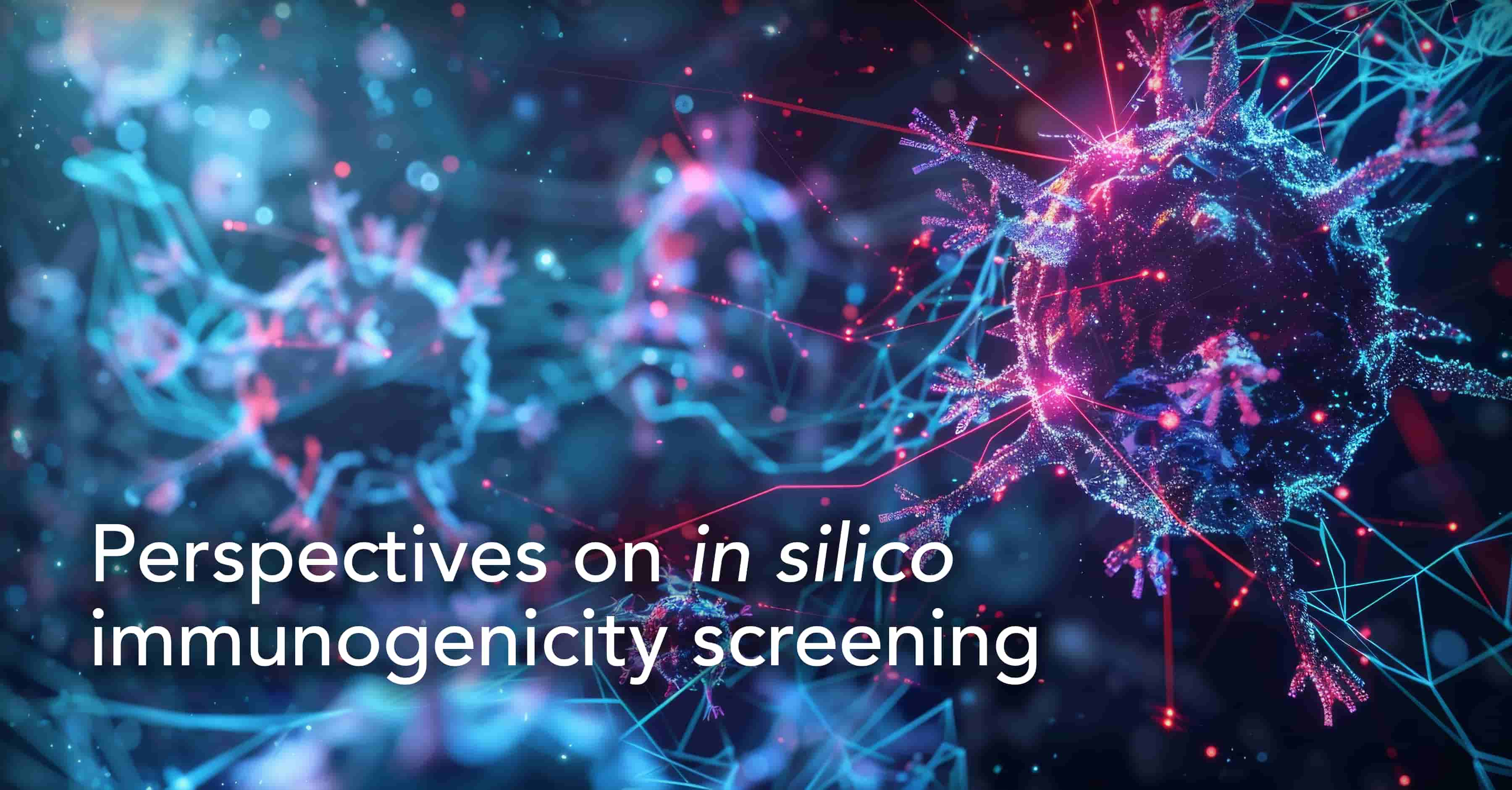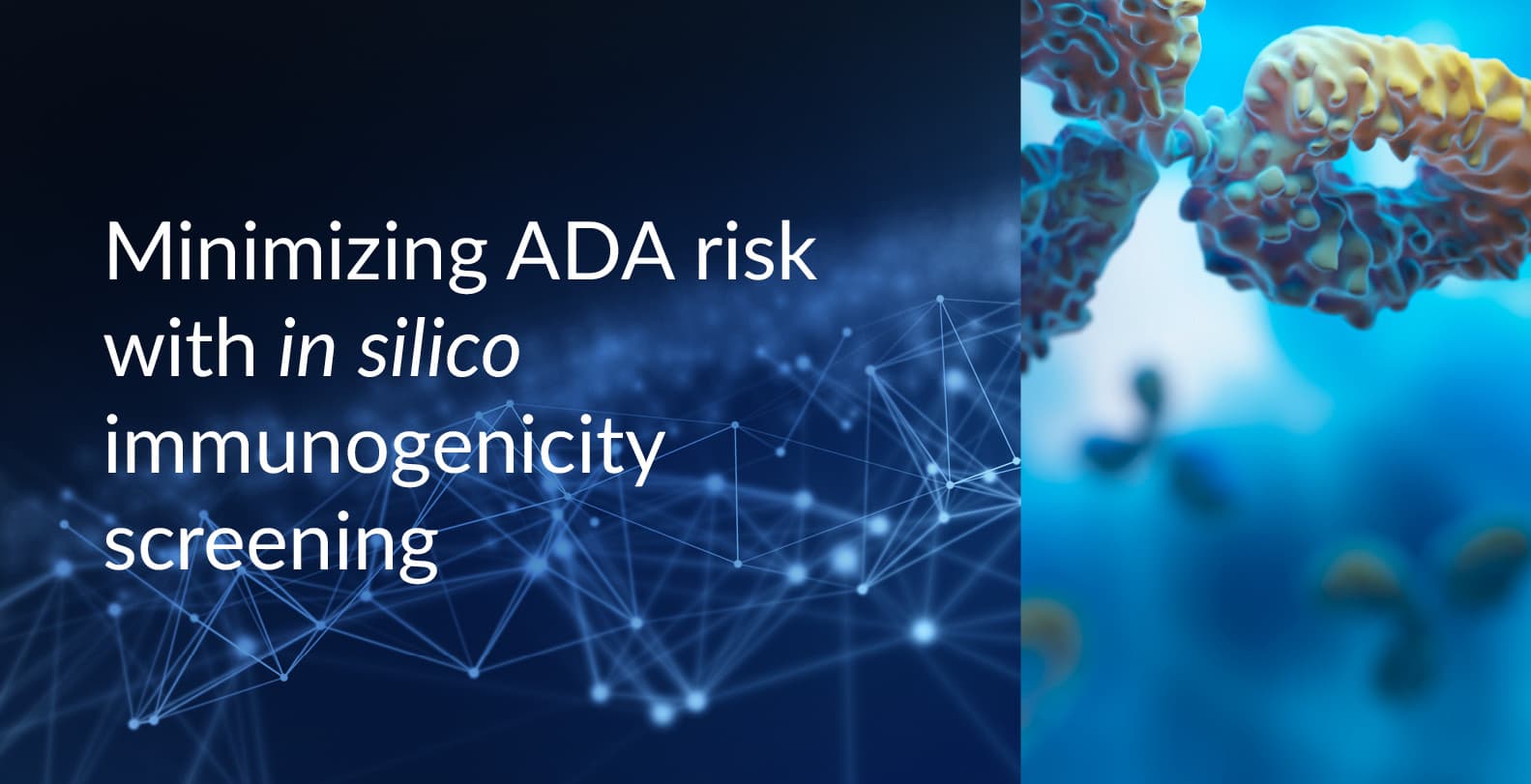Perspectives on in silico immunogenicity screening

Understanding immunogenicity
At its core, immunogenicity refers to the ability of a substance, typically a drug or vaccine, to provoke an immune response within the body. It's the biological equivalent of setting off alarm bells. The stronger the response, the louder these alarms ring. In the case of vaccines, it is required for proper functioning of the vaccine: inducing an immune response and creating immunological memory. However, in the context of therapeutics, and particularly biotherapeutics, an unwanted immune response can potentially reduce the drug's efficacy or even lead to adverse effects.
In pharma, the watchful eyes of agencies such as the FDA and EMA ensure that only the safest and most effective drugs make their way to patients; they require immunogenicity testing data before approving clinical trials and market access. These bodies necessitate stringent immunogenicity testing, especially for biosimilars, where it's essential to demonstrate that the biosimilar product has no increased immunogenicity risk compared to the reference product (1 EMA), (2 FDA).
The interaction between the body's immune system and biologic drugs, such as monoclonal antibodies, can result in unexpected and adverse outcomes. Cases have been reported where anti-drug antibodies (ADA) led to lower drug levels and therapeutic failures, such as in the use of anti-TNF therapies, where patient immune responses occasionally reduced drug efficacy (3). Beyond monoclonal antibodies, other biologic drugs, like enzyme replacement therapies and fusion proteins, also demonstrate variability in patient responses due to immunogenicity. In some instances, enzyme replacement therapies have been less effective because of immune responses that neutralize the therapeutic enzymes. Similarly, fusion proteins used in treatments have shown varied efficacy, potentially linked to the formation of ADAs. The critical nature of immunogenicity testing is underscored by these examples, highlighting its role in ensuring drug safety and efficacy across a broader range of biologic treatments.
The challenge is to know beforehand whether an immune response will develop, ie the immunogenicity of a compound.
A deep dive into immunogenicity assessment of therapeutic antibodies
Researchers rely on empirical analyses to comprehend the immune system's intricate interactions with external agents. Immunogenicity testing is the lens that magnifies this interaction, revealing the nuances that can determine a drug's success or failure.
Empirical analyses in immunogenicity assessments are informative but come with notable limitations. These analyses are often time-consuming, posing challenges to rapid drug development. Early-phase clinical testing usually involves small sample sizes, which restricts the broad applicability of the results. Pre-clinical tests, typically performed on animals, have limited relevance to human responses, primarily due to small sample sizes and interspecies differences.
Additionally, in vitro tests using human materials do not fully encompass the diversity and complexity of the human immune system. Moreover, they often require substantial time, resources, and materials. These issues highlight the need for more sophisticated methodologies that integrate human genetic variation for better prediction of drug candidates' efficacy.
Furthermore, the ability to evaluate the outputs from phage libraries during the discovery stage and optimization strategies like humanizations, developability, and affinity maturation can add significant value. Being able to analyzing these strategies' impact on immunogenicity, with novel tools , may enhance the precision of these high throughput methods.
.
The emergence of in silico in immunogenicity screening
With the dawn of the digital age, computational methods have become integral to immunogenicity testing. In silico testing, grounded in computer simulations, introduces an innovative and less resource-intensive approach. However, it's important to understand that despite their advancements, in silico methods are not entirely predictive. There remains a grey area of uncertainty that can only be fully understood through experimental and clinical testing with actual patients. This underscores the importance of a multifaceted approach that combines computational predictions with empirical experimental and clinical data to comprehensively assess a drug's immunogenicity.
Predictive role
Immunogenicity testing is integral to drug development, serving both retrospective and predictive purposes. In silico analyses utilizing artificial intelligence and computational models to forecast a drug's behavior within the body can be used both in early and late stages of drug development. These predictions can also guide subsequent in vitro analyses, where the drug's cellular interactions are studied in a controlled laboratory environment. As a final step, traditionally immunogenicity monitoring in patients is crucial for regulatory approval.
The future of drug development envisions an expanded role for in silico testing through the combination with experimental and clinical data, to enhance the accuracy of predictive immunogenicity. This approach aims to refine predictions about a drug's safety and effectiveness before clinical trials, potentially streamlining the drug approval process.
By understanding how a drug interacts with the immune system, researchers can anticipate possible reactions, optimize treatment strategies, and monitor patients throughout the process. Understanding a drug's potential immunogenicity can inform dosing strategies, patient monitoring, and risk management. For instance, dose adjustments or alternative therapies might be considered if a particular population is likely to develop ADAs against a drug early on.
Traditional vs. in silico methods: A comparative analysis
Traditional in vitro methods, despite being time-intensive, offer direct insights from real-world biological interactions. However, it's important to recognize the limitations in the reliability of these methods, especially concerning in vitro wet lab tests used to determine a molecule's immunogenicity in humans. These tests often fall into a grey area in terms of their predictive accuracy for human responses.
Given this, the potential benefits of in silico analyses become more pronounced. In silico methods can complement traditional approaches by providing additional predictive insights, particularly in the early stages of drug development where empirical data might be limited. This integration of computational analyses can help identify potential immunogenic issues earlier in the drug development process, aiding in the efficient design of subsequent empirical studies. In silico methods, with their rapid processing and efficiency, are ideal for initial screenings, large datasets, and iterative testing. Large amounts of hits can already be screened in the discovery stage and repeated when lead candidates are chosen and further engineered. The advantage of in silico methodologies lies in their capacity for high throughput analysis and quick turn-around times.
Traditional testing methods, while necessary for regulatory approval, present challenges in high throughput analysis due to their reliance on specialized reagents, materials, and equipment. These requirements not only incur substantial costs but also necessitate significant human expertise and logistical arrangements for sample storage. On the other hand, in silico testing, grounded in digital prowess, sees the majority of its costs stemming from software and hardware acquisition, personnel and maintenance.
By employing in silico techniques, it becomes feasible to rapidly screen and eliminate unsuitable drug candidates early in the discovery and development process. This early-stage screening significantly enhances the efficiency of the drug development pipeline by focusing resources and efforts on the most promising candidates.
Consequently, the real cost-saving potential of in silico analysis emerges from its ability to streamline the candidate selection process, ensuring that only the most viable leads progress to costly traditional testing and clinical trials.
Advantages of in silico in immunogenicity screening
In silico immunogenicity testing is transforming drug development by offering rapid insights and early triaging, which is instrumental in de-risking the pipeline and reducing attrition costs. These methodologies can convert extensive research timelines into days or hours, vastly accelerating the early stages of drug discovery and validation.
As in silico testing minimizes the need for extensive testing of high number of candidates in vitro, its true value lies in its ability to facilitate early-stage decision-making. This early triaging helps identify potential failures before significant investment, thereby lowering the financial risks associated with drug development.
In silico immunogenicity screening in decision-making
Employing an in silico platform enables researchers to thoroughly investigate the molecular structure, function, and potential interactions of proteins at an early stage. This process aids in the early triaging of drug candidates by identifying subtle variations that could affect therapeutic efficacy or safety. Additionally, the insights gleaned from in silico analyses can inform our understanding of how these molecular characteristics may relate to clinical outcomes, enriching the knowledge base from which we draw predictions about a drug's performance in real-world.
De-risking with informed lead nomination
The earliest stages of therapeutic development hinge on selecting the right lead candidates—molecules or compounds that exhibit the potential for longevity. Making an informed choice at this stage can be the difference between success and failure. In-depth analysis such as immunogenicity analysis aims to validate that selected leads are effective and exhibit a high safety profile.
To benefit from the potential and efficiency of in silico methods in drug discovery, it's crucial to choose the right platform to realize these advantages. This is where LENSai Integrated Intelligence Technology comes into play. Introducing the future of protein analysis and immunogenicity screening: LENSai. Powered by the revolutionary HYFT technology, LENSai is not just another tool; it's a game-changer designed for unmatched throughput, lightning-fast speeds, and accuracy. Streamline your workflow, achieve better results, and stay ahead in the ever-evolving world of drug discovery. Experience the unmatched potency of LENSai Integrated Intelligence Technology.
Learn more: LENSai in silico Immunogenicity Screening
Understanding immunogenicity and its intricacies is fundamental for any researcher in the field. Traditional methods, while not entirely predictive, have been the cornerstone of immunogenicity testing. However, the integration of in silico techniques is enhancing the landscape, offering speed and efficiency that complement existing methods. At BioStrand we foresee the future of immunogenicity testing in a synergistic approach that strategically combines in silico with in vitro methods. In silico immunogenicity prediction can be applied in a high throughput way during the early discovery stages but also later in the development cycle when engineering lead candidates to provide deeper insights and optimize outcomes. For the modern researcher, employing both traditional and in silico methods is the key to unlocking the next frontier in drug discovery and development.
Looking ahead, in silico is geared towards becoming a cornerstone for future drug development, paving the way for better therapies.
References:
Subscribe to our Blog and get new articles right after publication into your inbox.
Subscribe to our blog:






